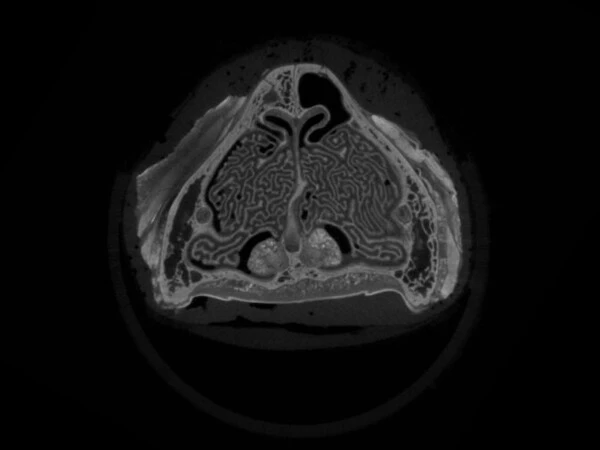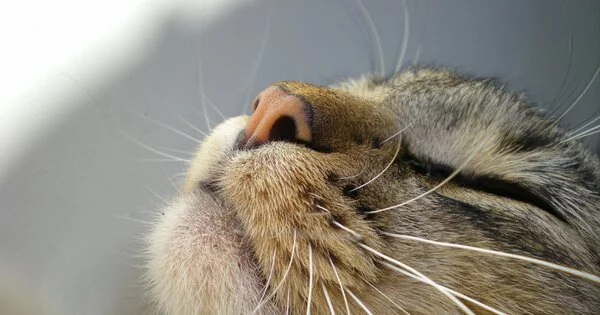The cat’s nose has a highly developed sense of smell, allowing it to detect and distinguish between different scents. Millions of specialised olfactory receptors line the inside of a cat’s nose. These receptors are sensitive to the various chemical compounds found in odours. These compounds bind to the olfactory receptors when they enter the cat’s nasal passages.
Scientists have discovered the secret to felines’ ability to detect food, friends, and foes. According to the first detailed analysis of the domestic cat’s nasal airway, the credit goes to a complex collection of tightly coiled bony airway structures.
Scientists have discovered the secret to felines’ ability to detect food, friends, and foes. According to the first detailed analysis of the domestic cat’s nasal airway, the credit goes to a complex collection of tightly coiled bony airway structures.
The researchers created a 3D computer model of the cat nose and simulated how air containing common cat food odours would flow through the coiled structures during an inhalation. They discovered that the air separates into two flow streams, one that is cleansed and humidified and another that quickly and efficiently delivers the odorant to the system responsible for smell – the olfactory region.
We spent a lot of time developing the model and conducting more sophisticated analyses to understand the functional benefit that this structure serves. The cat’s nose probably has a similar level of complexity as the dog’s, and it’s more complex than a rodent’s – which begs the question, why was the nose evolved to be so complex?
Kai Zhao
The cat nose, according to the researchers, functions as a highly efficient and dual-purposed gas chromatograph – a tool that detects and separates chemicals in vaporised form in the laboratory. In fact, the cat nose is so effective at this that its structure may inspire improvements to today’s gas chromatographs.
While the long alligator nose has been found to mimic gas chromatography, scientists believe that the compact cat head drove an evolutionary change that resulted in the labyrinthine airway structure that not only fits, but also helps cats adapt to diverse environments.
“It’s a good design if you think about it,” said Kai Zhao, senior author of the study and associate professor of otolaryngology at Ohio State’s College of Medicine.
“Olfaction is critical for mammals in finding prey, identifying danger, locating food sources, and tracking their environment.” In fact, a dog can sniff something and tell whether it was a friend or not,” he explained. “That’s an amazing olfactory system, and I believe there have been different ways to evolve to improve it.” We believe that by observing these flow patterns and analysing the details of these flows, we can identify two distinct flow zones that serve two distinct purposes.”
The study was published in the journal PLOS Computational Biology.

Zhao’s lab has previously created models of the rat and human noses to study airflow patterns, but the high-resolution cat model and simulation experiments, based on micro-CT scans of a cat’s head and microscopic-level identification of tissue types throughout the nasal cavity, are his most complex to date.
“We spent a lot of time developing the model and conducting more sophisticated analysis to understand the functional benefit that this structure serves,” he explained. “The cat nose probably has a similar level of complexity as the dog’s, and it’s more complex than a rodent’s – which begs the question, why was the nose evolved to be so complex?”
Breathing simulations on computers revealed the answer: Researchers observed two distinct regions of air flow during a simulated inhalation: respiratory air, which is filtered and spreads slowly above the roof of the mouth on its way to the lungs, and a separate stream containing odorant, which moves rapidly through a central passage directly to the olfactory region towards the back of the nasal cavity. The flow’s location and speed through turbinates, the bony structures inside the nose, were both considered in the analysis.
“We measured how much flow goes through specific ducts – one duct that delivers most odorant chemicals into the olfactory region, versus the rest, and analyzed the two patterns,” Zhao said. “For respirant breathing, turbinates branch to divert flow into separate channels, sort of like a radiator grid in a car, which would be better for cleansing and humidifying.
“But you want odour detection to be very fast, so there is one branch that delivers odour at high speed, potentially allowing for quick detection rather than waiting for air to filter through the respiratory zone – you could lose most of the odour if the air has been cleansed and the process is slowed down.”
The simulation also revealed that once in the olfactory region, the air is recirculated in parallel channels. “That was actually a surprise,” Zhao said. “It’s like when you take a sniff, the air shoots back there and is then processed for a much longer period of time.”
This is the first study to quantify the difference in gas chromatography between mammals and other species – Zhao and colleagues estimate the cat’s nose is more than 100 times more efficient at odour detection than an amphibian-like straight nose in a similarly sized skull – and to propose a parallel gas chromatography theory: parallel olfactory coils feeding from the fast stream to increase the effective length of the flow path while slowing down the local air flow.
















